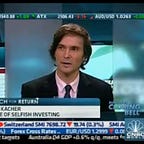What was your biggest investment mistake?
Before I knew much about stocks, I was gifted 100 shares of Apple Computer (AAPL) in 1982 at a split adjusted 25 cents (a quarter) a share. That $25 investment today would be worth $120,000.
But this cautionary post is not about selling one of the best performing stocks in history.
After having traded the US stock markets for nearly 30 years, it brings to mind what the legendary investor Jesse Livermore said. There are more ways one can lose money than one could possibly imagine.
So each time I felt I finally figured out the markets, I would have yet another hard lesson thrown at me.
I have certainly made more than my share of mistakes. Emotional. Tactical. Physical.
Emotional: Know thyself. As I wrote a number of times in books I have published (google Chris Kacher), understanding one’s personal investment psychology is key. One’s tolerance for risk is like a fingerprint. It is unique to each individual. Thus, one must soul search to understand their level of risk on an emotional level. The only way to do this is to risk actual capital in the investment(s). One must experience how it feels to make and lose money. Only then will one truly know the risk they are willing to take with their hard-earned capital.
Tactical: This is tied in with understanding one’s emotions. It is key you create an investment strategy that fits your risk tolerance profile. When I created my VIX Volatility Model (VVM) algorithm, its results were astounding, quite beyond anything I had created in nearly 30 years of trading. It even bested in backtests the KPMG verified string of triple digit percentage returns I achieved each year from 1995 to 2000.
Yet my many years of experience worked against me. The algorithm would often switch signals at what I deemed to be the worst possible time. So I would ignore the signal. In overriding the signal, I often lost out big on profits. To compound the frustration, I held a couple signals too long against the model’s signals resulting in larger losses.
I realized that I must take *all* of the model’s signals rather than trying to cherry pick the signals that made me feel the most comfortable.
Indeed, the trade that often feels “wrong” is often the right and profitable trade to make when it comes to investing in stocks or timing the market.
Fortunately, after some growing pains, I am able to take all of the model’s signals. The algorithm also went through some debugging much as software would. Consequently, the VIX Volatility Model is up +31.7% in 2017 as of 1–27–17. A great deal of work has been put into VVM to debug and improve its reliability. This work showed a backtested result of +177.03% at its peak in 2016. In addition, profit/loss was improved for each year going back to 2009. I share the results HERE.
Physical: Trading requires optimal focus. I realized long ago that everything is tied together when it comes to investing, and when it comes to life. If my mind and body were not running at full health, it would naturally affect my focus and therefore my trading. I wrote this article which went viral on how to supercharge your level of focus. It reveals what I do before the market opens.
What I Learned: Experience can work against you. My reputation and years of experience made me fall into the “guru” trap. Just because I have had many years of success as a trader, and just because many have learned from my teachings, does not mean I am still not a student. As my mentor the legendary investor William O’Neil used to tell me, he remains a humble student when it comes to the markets. He told me this when he was in his 60s as we worked closely together for several years as I was his head analyst and top performing portfolio manager.
So just because you design a strategy from the ground up, it does not mean you will be able to trade it successfully. You must align your emotions and experience with that of the strategy. Only then can you take every signal. Only then can you stick to the strategy.
I have always said to anyone who wishes to use a trading strategy or market timing method that is not their own, and this includes constant reminders to our members, that they must understand the risk/reward behind each of my two algorithmic trading strategies. I post all results so members can understand worst case scenarios. This helps each member determine position sizing limits based on how much risk they are willing to take.
I am the co-founder of Virtue of Selfish Investing, LLC and MoKa Investors, LLC. We run the website www.virtueofselfishinvesting.com.
